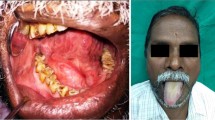Abstract
Purpose
Many dental procedures are at risk of injuring the lingual nerve. We performed this study to better elucidate the microanatomy that exists between the ipsilateral lingual and hypoglossal nerves so that iatrogenic injury can be avoided.
Methods
Adult human cadaveric tongues (ten sides) underwent Sihler’s staining to identify the microanatomy between the lingual and hypoglossal nerves.
Results
The lingual nerve entered the middle part of the anterior two-thirds of the tongue from its lateral side and divided into two to four thick branches. These branches were then disseminated to the anterior, middle, and posterior parts of the anterior two-thirds of the tongue via 7–14 thin nerve bundles as terminal branches. The hypoglossal nerve entered the tongue at the posterior border of its anterior two-thirds and traveled forward to the apex of the tongue on all sides. All specimens were found to have communicating branches between the lingual and hypoglossal nerves at its anterior, middle, and posterior thirds.
Conclusions
Our results indicate that the ipsilateral lingual and hypoglossal nerves constantly have three connections on each side between them. This knowledge might aid the dentist in minimizing iatrogenic nerve injury.




Similar content being viewed by others
References
Behnia H, Kheradvar A, Shahrokhi M (2000) An anatomic study of the lingual nerve in the third molar region. J Oral Maxillofac Surg 58:649–651 (discussion 652–643)
Doty RL, Cummins DM, Shibanova A, Sanders I, Mu L (2009) Lingual distribution of the human glossopharyngeal nerve. Acta Otolaryngol 129:52–56. doi:10.1080/00016480801998820
Elfring T, Boliek CA, Winget M, Paulsen C, Seikaly H, Rieger JM (2014) The relationship between lingual and hypoglossal nerve function and quality of life in head and neck cancer. J Oral Rehabil 41:133–140. doi:10.1111/joor.12116
Fitzgerald MJ, Law ME (1958) The peripheral connexions between the lingual and hypoglossal nerves. J Anat 92:178–188
Hwang K, Jin S, Park JH, Kim DJ, Chung IH (2007) Relation of mental nerve with mandibular branch of the facial nerve. J Craniofac Surg 18:165–168. doi:10.1097/SCS.0b013e31802d6e86
Iwanaga J, Saga T, Tabira Y, Nakamura M, Kitashima S, Watanabe K, Kusukawa J, Yamaki K (2015) The clinical anatomy of accessory mental nerves and foramina. Clin Anat 28:848–856. doi:10.1002/ca.22597
Mu L, Sanders I (2010) Human tongue neuroanatomy: nerve supply and motor endplates. Clin Anat 23:777–791. doi:10.1002/ca.21011
Ogata S, Mine K, Imamura R, Tamatsu Y, Shimada K (2006) Peripheral distribution of the human hypglossal and lingual nerves, with special reference to the hypoglossal-lingual communication. Keitai Kinou 4:47–52
Saigusa H, Tanuma K, Yamashita K, Saigusa M, Niimi S (2006) Nerve fiber analysis for the lingual nerve of the human adult subjects. Surg Radiol Anat 28:59–65. doi:10.1007/s00276-005-0037-0
Shinohara H, Mataga I, Kageyama I (2010) Discussion of clinical anatomy of the lingual nerves. Okajimas Folia Anat Jpn 87:97–102
Sihler C (1895) Über muskelspindeln und intramuskuläre nervenendigungen bei schlangen und fröschen. Arch Mikrosk Anat 46:709–723
Toure G, Bicchieray L, Selva J, Vacher C (2005) The intra-lingual course of the nerves of the tongue. Surg Radiol Anat 27:297–302. doi:10.1007/s00276-005-0335-6
Yang HM, Won SY, Kim HJ, Hu KS (2013) Sihler staining study of anastomosis between the facial and trigeminal nerves in the ocular area and its clinical implications. Muscle Nerve 48:545–550. doi:10.1002/mus.23875
Yang HM, Woo YJ, Won SY, Kim DH, Hu KS, Kim HJ (2009) Course and distribution of the lingual nerve in the ventral tongue region: anatomical considerations for frenectomy. J Craniofac Surg 20:1359–1363. doi:10.1097/SCS.0b013e3181ae42fa
Zur KB, Mu L, Sanders I (2004) Distribution pattern of the human lingual nerve. Clin Anat 17:88–92. doi:10.1002/ca.10166
Acknowledgements
The authors wish to thank the individuals who donated their bodies and tissues for the advancement of education and research.
Author information
Authors and Affiliations
Corresponding author
Ethics declarations
Conflict of interest
The authors have not received any funding or Grant for this work from organizations or foundations. The authors declare that they have no conflicts of interest.
Rights and permissions
About this article
Cite this article
Iwanaga, J., Watanabe, K., Saga, T. et al. Communicating branches between lingual and hypoglossal nerve: observation using Sihler’s staining technique. Surg Radiol Anat 39, 741–745 (2017). https://doi.org/10.1007/s00276-016-1789-4
Received:
Accepted:
Published:
Issue Date:
DOI: https://doi.org/10.1007/s00276-016-1789-4




